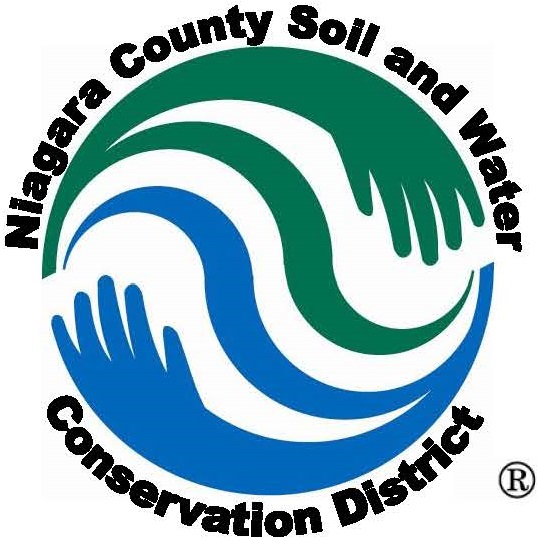|
4 Hr.Erosion and Sediment Control Trainings
Niagara County SWCD will host 4 hour Erosion and Sediment
Control trainings on January 15, 2026 and February 26, 2026. Flyer and
registration links are below.
You may call our office (716-434-4949 x4) or send our
staff an email from our
Contacts
to schedule meetings or request appointments.
Many homeowners have already
contacted us to have a pond site suitability assessment completed. Most
towns require these assessments to be completed before pond excavation can occur. If you
are interested in putting a pond on your property, call us today or check
for more details in our programs page.
Niagara County Soil Survey
Click here to download a digital copy of the Soil Survey of
Niagara County book. This can be very useful for farming, building or
creating ponds.
|
|
NIAGARA COUNTY SOIL & WATER CONSERVATION
DISTRICT |
 |
 |
|
SOIL AND WATER CONSERVATION DISTRICTS (SWCDs)
What is a Conservation District
Conservation districts are local governmental subdivisions established under state law to carry out a program for the
conservation, use and development of soil, water and related
resources. Districts are resource management agencies, coordinating
and implementing resource and environmental programs at the local
level in cooperation with federal and state agencies.
History
Conservation districts had their beginning in the 1930s when
Congress, in response to national concern over mounting erosion,
floods and sky-blackening dust storms that swept across the country,
enacted the Soil Conservation Act of 1935. The act stated for the
first time a national policy to provide a permanent program for the
control and prevention of soil erosion, and directed the Secretary
of Agriculture to establish the Soil Conservation Service to
implement this policy. The conservation district concept was
developed to enlist the cooperation of landowners and occupiers in
carrying out the programs authorized by the act.
To encourage local participation in the program, President Roosevelt
sent all state governors A Standard State Soil Conservation
Districts Law, with a recommendation for enactment of legislation
along its lines. On March 3, 1937, Arkansas became the first state
to adopt a law modeled on the Standard Act. On August 4, 1937, the
first conservation district, the Brown Creek District included the
birthplace of Dr. Hugh Hammond Bennett, the first Chief of the Soil
Conservation Service - commonly referred to as the father of soil
conservation. By 1938, twenty-seven states had followed suit, and by
the late 1940s, all fifty states had adopted similar legislation.
District's laws were adopted in the 1960s by Puerto Rico and the
Virgin Islands, and in the 1980s by the District of Columbia, Guam,
and the Northern Mariana Islands. Niagara County SWCD was formed on
November 3, 1954.
What Do Districts Do?
Districts work with landowners, land managers, local government
agencies, and other local interests in addressing a broad spectrum
of resource concerns: erosion control, flood prevention, water
conservation and use, wetlands, ground water, water quality and
quantity, nonpoint source pollution, forestland protection,
wildlife, recreation, waste water management and community
development.
How Many Districts are There?
In New York, there are 58 conservation districts, one representing
each county and five districts represent the boroughs of New York
City. Collectively, the 58 districts are represented by the New York
Association of Conservation Districts (NYACD). Nationwide, there are
approximately 3,000 conservation districts, the number varying from
time to time as a result of the combination, division, or the other
restructuring of district boundaries. These districts, identified in
some states as soil conservation districts, conservation districts,
natural resources conservation districts, natural resource districts
or resource conservation districts, cover 98 percent of the
privately owned land in the fifty states, the District of Columbia,
Puerto Rico, the Virgin Islands, the Northern Marian Islands, and
Guam.
Niagara County Soil & Water Conservation District
Niagara County is situated in the northwestern part
of New York, in the angle between Lake Ontario and the Niagara
River. Orleans County and a small portion of Genesee County form the
eastern boundary. Tonawanda Creek separates it on the south from
Erie County.
The County is roughly rectangular in shape, and
contains 349,952 acres or about 547 square miles. Viewed in its
physiographic relation to the remainder of New York State, the
county occupies portions of two great lake plains, which in this
region are separated by a sharp change in level of approximately 200
feet. These are the Ontario and Erie plains, which extend eastward
around Lake Ontario and westward into Canada.

|
|
|
 Non-Discrimination Statement Non-Discrimination Statement
"The U.S. Department of Agriculture (USDA) prohibits discrimination in all its
programs and activities on the basis of race, color, national origin, age,
disability, and where applicable, sex, marital status, familial status, parental
status,
religion, sexual orientation, genetic information, political beliefs,
reprisal, or because all or part of an individual's income is derived from any
public assistance program. (Not all prohibited bases apply to all programs.)
Persons with disabilities who require alternative means for communication of
program information (Braille, large print, audiotape, etc.) should contact
USDA's TARGET Center at (202) 720-2600 (voice and TDD). To file a complaint of
discrimination write to USDA, Director, Office of Civil Rights, 1400
Independence Avenue, S.W., Washington, D.C. 20250-9410 or call (800) 795-3272
(voice) or (202) 720-6382 (TDD). USDA is an equal opportunity provider and
employer."
|

